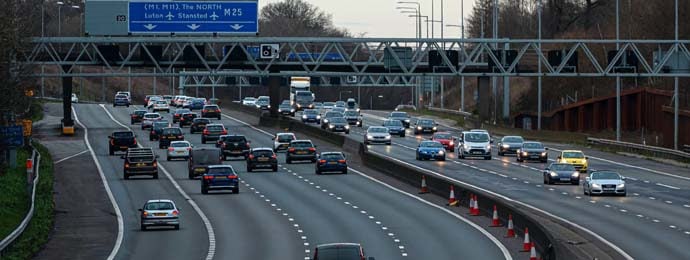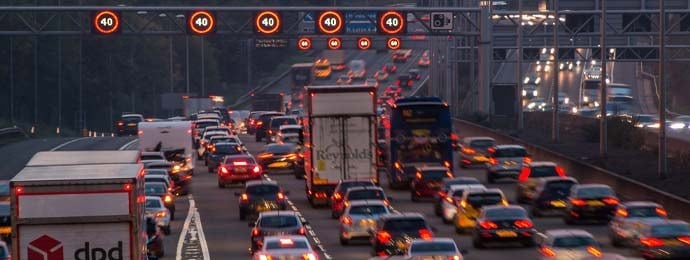The drivers’ guide to smart motorways
Smart motorways have been a feature of British roads since 2006, when the first trial was introduced on the M42 in the West Midlands. However, despite over 14 years of driving on them, it’s safe to say the UK’s motorists still aren’t always clued up on just how smart they are.
In the last five years, 38 people have died as a result of accidents on smart motorways, while on the M25 - a smart motorway near London - near misses have increased by 20 times since the road was converted.
This guide looks at what a smart motorway is and how you can best use it to get where you’re going safely.

What is a smart motorway?
A smart motorway is different to a normal motorway for a few reasons. For a start, there’s no hard shoulder. Unlike on regular motorways, where the hard shoulder is a lane for emergency use only, smart motorways use it as an extra lane of live traffic. The aim is to ease congestion at peak times, with more space on the roads for cars to filter into to help them get from A to B in less time.
Smart motorways are also ‘managed’. This means there are cameras watching them, allowing their operators to slow traffic down, close off lanes or request emergency support depending on what’s going on. When driving on them, these instructions will be displayed on live signs above the lanes. You can see anything on them from reduced speed limits, through to escaped animals or accident warnings.
Because of their constant monitoring, in theory you should be able to break down at any stage of a smart motorway and have help sent out as soon as you need it. The lane should be closed off behind you and other drivers alerted to your presence, preventing a crash and keeping you safe until support arrives.
Which UK roads are smart motorways?
Smart motorways cover 488 miles of UK roads, with an additional 300 miles planned by 2025. The intention is to make the UK’s motorway system the safest in the world, easing ever-growing congestion and helping the environment through less idle traffic. With the government’s carbon emission targets in place, smart motorways can play a key role in lowering the country’s pollution problem.
The following table shows you which roads are smart motorways, and what type of system they have in place. ‘All lane running’ means there is no hard shoulder - all the lanes are live for you to drive in. A ‘dynamic hard shoulder’ is sometimes a live lane, sometimes not. It will be opened up to ease congestion. A ‘controlled motorway’ has three lanes with variable speed limits, displayed on the overhead signage. The hard shoulder remains and should only be used in an emergency.
All lane running | Dynamic hard shoulder | Controlled motorway | Junctions |
|---|---|---|---|
M1 | J16 to J13 (under construction) | J10 to J13 | J6a to J10 |
M3 | J2 to 4a | ||
M4 | J3 to J12 (under construction) | J19 to J20 | |
M5 | J4 to J6 | J15 to J17 | |
M6 | J2 to J4 (under construction) | J4 to J10a | J10a to J11a |
M20 | J3 to J5 (under construction) | J4 to J7 | |
M25 | J5 to J6/7 | J2 to J3 | |
M23 | J8 to J10 | ||
M26 | |||
M27 | J4 to J11 (under construction) | ||
M40 | |||
M42 | J7 to J9 | ||
M60 | J8 to J18 | ||
M62 | J10 to J12 (under construction) | J23 to J30 | J28 to J29 |
Does a smart motorway actually make roads safer?
In 2018, there were nine deaths on smart motorways, compared to 77 on conventional motorways, suggesting that the safety technology is working. They also reduced journey times by an average of four minutes, while pollution on the roads is down too.
However, despite those statistics, the public still aren’t on board. In a recent survey, 68% of drivers said they didn’t think smart motorways were safe, while others claimed that the cost involved wasn’t worth the results delivered. Each mile of smart motorway costs between £5 million and £15 million to build, and takes around two years to complete.
Only 9% of drivers felt completely safe on a smart motorway, and a government review published in March 2020 said that there would be changes to how the roads were designed to make them easier to understand.
This could lead to clearer signage, or more training in how to use the roads as part of driving lessons. As of 2018, motorway driving rules were added to Driving Theory tests. Smart motorways could soon be making an appearance too.

Are smart motorways dangerous?
The main risks on a smart motorway come from a lack of awareness of how they work. While lane closures should prevent any accidents occurring within them, if a driver misses the sign (or thinks they can ignore it) any car stranded there will be left as a sitting duck.
Another risk factor is the time it takes for cameras to spot an issue. On average, it takes 17 minutes for an operator to notice a car in distress, and a further 17 minutes for someone to get out to help. That’s over half an hour of a car being stuck, surrounded by vehicles traveling at up to 70mph.
While smart motorways were designed to increase driver safety, the way drivers use them could be having an opposite effect. If signs are disregarded and speed limits aren’t adhered to, you could be putting many lives, including your own, at risk.
Speed limits on live signage are legal limits. They’re not there just for guidance. If the motorway cameras spot you exceeding the changed speed limit, you will be fined just as you would on any other road.
“Smart motorways differ from traditional motorways because they use roadside technology alongside control centres and operational procedures. They are designed to reduce congestion and improve journey times by better managing traffic.”

What happens if you break down on a smart motorway?
If you’re unfortunate enough to break down on a smart motorway, the advice changes depending on the kind of breakdown you’re experiencing. If it is possible and safe to do so, you should aim to pull into the next emergency refuge area. All smart motorways have emergency refuge areas at intervals of 500 to 800 metres. There you find an emergency telephone that you can use to alert the Control Centre. If you can’t make it to the next emergency refuge area and the hard shoulder is not in use, you should pull into the hard shoulder and call for assistance.
In either case, as soon as you have parked up you should exit your vehicle through the passenger side door, away from the live traffic, and stand on the opposite side of the safety barrier as far away from the traffic as possible.
If you break down in live traffic and cannot pull into an emergency refuge area or hard shoulder, or if the hard shoulder is in use, you should not exit your vehicle. Instead, put your hazard lights on, call 999 immediately and tell them your location and the lane you are in. This will help Highways England find you on the cameras as quickly as possible and they will close the lane you are in and send help.
What do you need to know before driving on a smart motorway?

Look out for signage
Smart motorways have live signage above them, letting you know which lanes are open and what speed you should be doing. Some might advise you of a revised speed limit, while others will tell you to move over a lane, warn you of delays ahead or of a recent accident. Keep an eye out for them and follow what they say.

Use the open lanes
While it might feel strange to drive on the very inside lane, it’s open for a reason. By using them you’ll reduce congestion and make your journey easier.

Stick to the speed limit
If the sign says drive at 50mph, that’s exactly what you should do. It’s that slow for a reason - there could be an accident up ahead, debris on the road or even an animal on the loose. Slow down and drive safely.
What about other motorways?
All UK motorways follow the same basic rules. Our guide to driving on the motorway covers all of them, helping you get where you’re going safely without getting caught on camera.
Looking for more road law guidance? Nationwide Vehicle Contracts produce various guides on all things road law, from Drink Driving to Car Seats.
We are also one of the UK's largest car leasing brokers and offer a range of leasing deals, including our used car leasing and fast lease services.
Guide Information
Originally published: 14th April 2021
